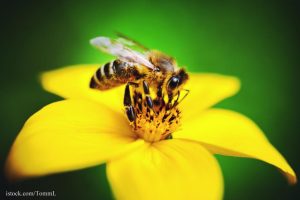The Colony Collapse Disorder among bees, an alarming development in the food world, has raised concerns about the future of our food supply. Since 1990, more than 25% of the managed honey bee population has disappeared. Without bee pollination, we would lose at least 30% of the world’s food crops.
 Beekeepers first noticed this issue in 2006. Bees were flying away from their hives and never returned. The number of bee hives in this country is now at its lowest point in 50 years. Experts believe this is happening because of a combination of global warming, which changes the timing of flower blooming, pesticide use, habitat loss, and parasites. Pesticides may make bees more susceptible to parasites and disease.
Beekeepers first noticed this issue in 2006. Bees were flying away from their hives and never returned. The number of bee hives in this country is now at its lowest point in 50 years. Experts believe this is happening because of a combination of global warming, which changes the timing of flower blooming, pesticide use, habitat loss, and parasites. Pesticides may make bees more susceptible to parasites and disease.
The Environmental Protection Agency (EPA) in the United States has been studying this issue. Last week they released a joint report with the USDA about Colony Collapse Disorder. The report stated that “acute and sublethal effects of pesticides on honey bees have been increasingly documented, and are a primary concern.” But the agencies are not taking action to stop the use of the pesticides considered partially responsible for this problem.
These pesticides, called neonicotinoids, are linked to bee losses around the world. Scientists think that the chemicals interfere with the ability of bees to navigate and cause a decline in queen bee numbers. The pesticide stays in the plant as it grows, so bees are exposed through pollen, nectar, and leaf surface moisture. These pesticides are used on corn, canola, cotton, sugar beet, soybean, cereal grain, rice, and fruit and vegetable crops in this country.
The Center for Food Safety is calling on the EPA and USDA to take action and suspend these pesticides to save honey bees and our food supply. In the last year, more than a dozen peer-reviewed scientific studies have been published about the effects of neonicotinoids on bees. And the EPA is not going to conclude its review of neonicotinoids until 2018 at the earliest. Instead, they are advising industry on best management practices. The European Commission, in contrast, is imposing a two year ban on the pesticides.
In addition, the EPA just approved the pesticide sulfoxaflor, a fourth generation neonicotinoid, which is classified as “highly toxic to honey bees.” That chemical has warning labels that state “do not apply this product at any time between 3 days prior to bloom and until after petals fall” and tells farmers to notify beekeepers about this product use to “allow them to take additional steps to protect their bees.”
Colony Collapse Disorder is already having an effect on the California almond industry. This industry is particularly reliant on bees, requiring 1.6 million domesticated colonies to pollinate the trees. This winter, almond growers needed to scramble to find healthy bee colonies so they would have a crop to harvest.




